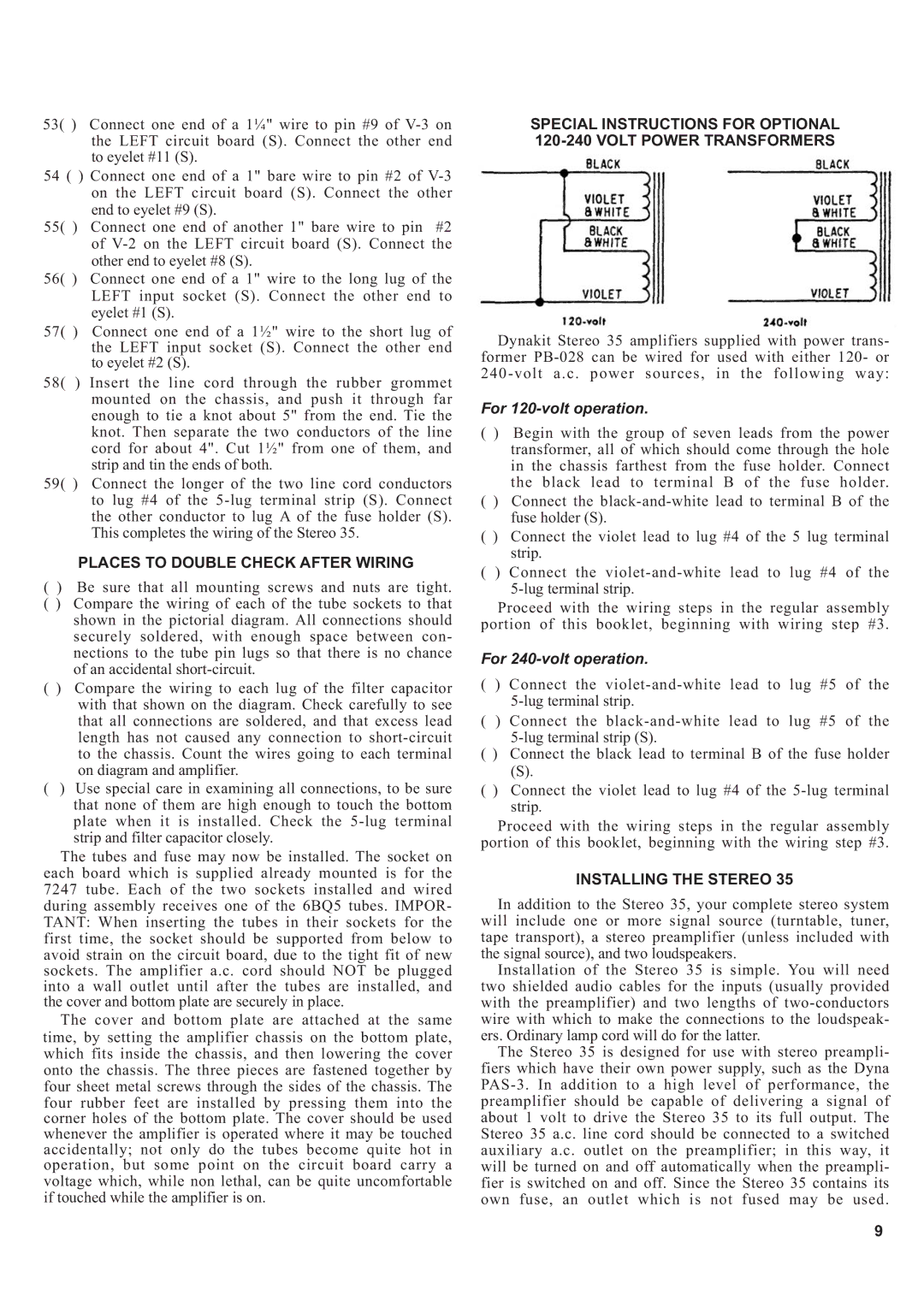
53( ) Connect one end of a 1¼" wire to pin #9 of
54 ( ) Connect one end of a 1" bare wire to pin #2 of
55( ) Connect one end of another 1" bare wire to pin #2 of
56( ) Connect one end of a 1" wire to the long lug of the LEFT input socket (S). Connect the other end to eyelet #1 (S).
57( ) Connect one end of a 1½" wire to the short lug of the LEFT input socket (S). Connect the other end to eyelet #2 (S).
58( ) Insert the line cord through the rubber grommet mounted on the chassis, and push it through far enough to tie a knot about 5" from the end. Tie the knot. Then separate the two conductors of the line cord for about 4". Cut 1½" from one of them, and strip and tin the ends of both.
59( ) Connect the longer of the two line cord conductors to lug #4 of the
PLACES TO DOUBLE CHECK AFTER WIRING
() Be sure that all mounting screws and nuts are tight.
() Compare the wiring of each of the tube sockets to that shown in the pictorial diagram. All connections should securely soldered, with enough space between con- nections to the tube pin lugs so that there is no chance of an accidental
() Compare the wiring to each lug of the filter capacitor with that shown on the diagram. Check carefully to see that all connections are soldered, and that excess lead length has not caused any connection to
() Use special care in examining all connections, to be sure that none of them are high enough to touch the bottom plate when it is installed. Check the
The tubes and fuse may now be installed. The socket on each board which is supplied already mounted is for the 7247 tube. Each of the two sockets installed and wired during assembly receives one of the 6BQ5 tubes. IMPOR- TANT: When inserting the tubes in their sockets for the first time, the socket should be supported from below to avoid strain on the circuit board, due to the tight fit of new sockets. The amplifier a.c. cord should NOT be plugged into a wall outlet until after the tubes are installed, and the cover and bottom plate are securely in place.
The cover and bottom plate are attached at the same time, by setting the amplifier chassis on the bottom plate, which fits inside the chassis, and then lowering the cover onto the chassis. The three pieces are fastened together by four sheet metal screws through the sides of the chassis. The four rubber feet are installed by pressing them into the corner holes of the bottom plate. The cover should be used whenever the amplifier is operated where it may be touched accidentally; not only do the tubes become quite hot in operation, but some point on the circuit board carry a voltage which, while non lethal, can be quite uncomfortable if touched while the amplifier is on.
SPECIAL INSTRUCTIONS FOR OPTIONAL
Dynakit Stereo 35 amplifiers supplied with power trans- former
For 120-volt operation.
() Begin with the group of seven leads from the power transformer, all of which should come through the hole in the chassis farthest from the fuse holder. Connect
the black lead to terminal B of the fuse holder.
() Connect the
() Connect the violet lead to lug #4 of the 5 lug terminal strip.
() Connect the
Proceed with the wiring steps in the regular assembly portion of this booklet, beginning with wiring step #3.
For 240-volt operation.
() Connect the
() Connect the
() Connect the black lead to terminal B of the fuse holder
(S).
() Connect the violet lead to lug #4 of the
Proceed with the wiring steps in the regular assembly portion of this booklet, beginning with the wiring step #3.
INSTALLING THE STEREO 35
In addition to the Stereo 35, your complete stereo system will include one or more signal source (turntable, tuner, tape transport), a stereo preamplifier (unless included with the signal source), and two loudspeakers.
Installation of the Stereo 35 is simple. You will need two shielded audio cables for the inputs (usually provided with the preamplifier) and two lengths of
The Stereo 35 is designed for use with stereo preampli- fiers which have their own power supply, such as the Dyna
9
